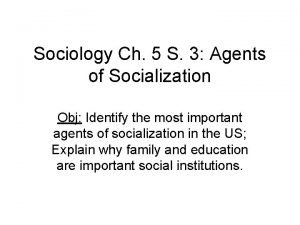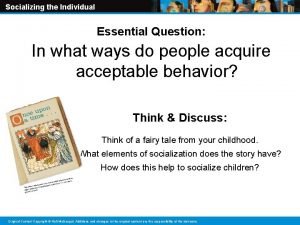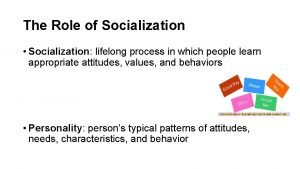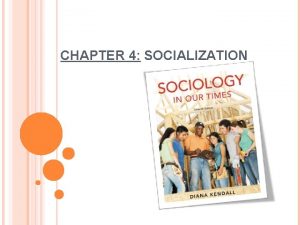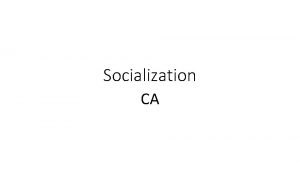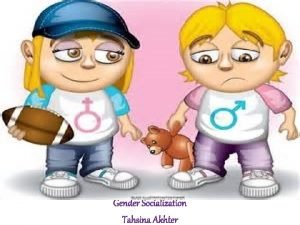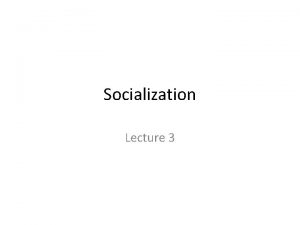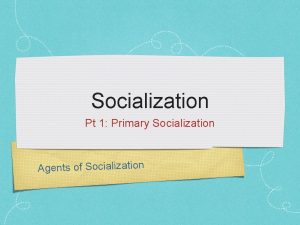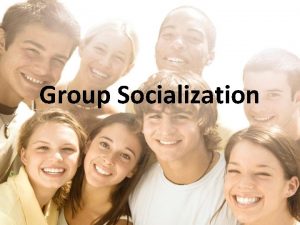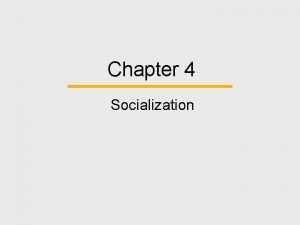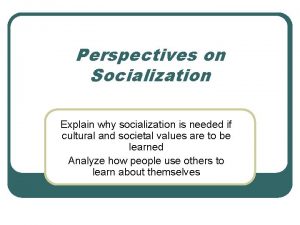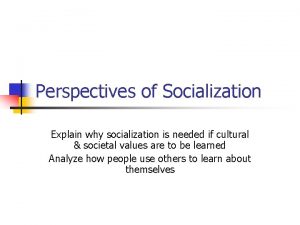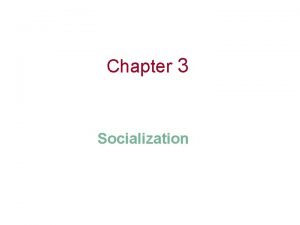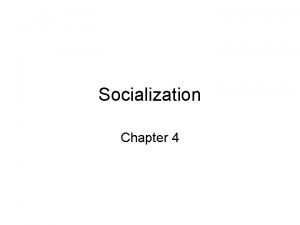CHAPTER 4 SOCIALIZATION WHY IS SOCIALIZATION IMPORTANT Socialization













- Slides: 13

CHAPTER 4: SOCIALIZATION

WHY IS SOCIALIZATION IMPORTANT? Socialization The lifelong process of social interaction through which individuals acquire a self-identity and the physical, mental, and social skills needed for survival in society It is the link between individual and society If culture is the “toolkit”, socialization is the “manual” What we become, how we act, think, and believe all comes from the socialization we receive Human beings are the most social creatures on Earth; and because of this, socialization is extremely important to the individual’s, as well as society’s, well being

NATURE AND NURTURE (AGAIN) How much of our being is dependent on nature and nurture? Many Sociologists will assert that though our preferences may be genetic; how we act, behave, and go about our lives are all a result of our socialization Sociobiologists believe that nature, and not nurture, will ultimately shape who we become Sociobiologists are concerned with the systematic study of how biology affects our social behavior While both sides wield evidence to their claims, it is widely accepted that both nature and nurture play a part in a much more complicated social equation

SOCIAL ISOLATION AND MALTREATMENT In order for humans (as well as other social animals) to develop properly, social contact early on is crucial See Harlows’ non-human primate experiment (pg. 108) Ultimately, social isolation was detrimental to the psychological growth of the Rhesus monkeys Cases of (extreme) social isolation and maltreatment in humans See Anna and Genie (pgs. 109 -110) Without socialization, and nurture, both children were devoid of language, cleanliness, upright movement; and in essence, their humanity Without a social catalyst during our core stages of development, we are nothing more than animals

HUMAN DEVELOPMENT: THE PSYCHOANALYTIC PERSPECTIVE Sigmund Freud (1856 -1939) His premise for human existence rested on two basic tendencies; the urge to survive, and the urge to procreate Consisted of three states that reflected different levels of personality The Id Most basic biological drives and demand for immediate gratification The Superego The sense of conscience, the moral and ethical aspects of ones actions The Ego The rational, reality oriented self that imposes restrictions on the Id Conscious Awareness: The iceberg analogy Both the Id and the Superego are unconscious states of awareness, whereas the ego is conscious i. e. the “tip of the iceberg” is the ego, whereas the rest of all of our unconscious thoughts and desires are “submerged”

Trust vs. Mistrust (birth to age one) If infants are nurtured they form a sense of trust, if they are neglected they will become mistrustful and anxious 2) Autonomy vs. Shame and Doubt (age one to three) If allowed to develop physical and mental abilities and allowed to control their environment, they develop autonomy, if they are discouraged they become doubtful 3) Initiative vs. Guilt (age three to five) If initiative is encouraged, children will develop the sense (of initiative), if ignored, may develop guilt 4) Industry vs. Inferiority (age six to eleven) Children seek to manipulate objects and become curious of their workings, encouragement develops the sense of industry; if regarded as a nuisance, children feel inferior 5) Identity vs. Role Confusion (age twelve to eighteen) Adolescents attempt to develop a sense of identity, in addition to having new roles; if an accurate sense of identity is not attained, the individual feels role-confusion 6) Intimacy vs. Isolation (age eighteen to thirty-five) The individual seeks to develop relationships, if they fail to do so isolation ensues 7) Generativity vs. Self-absorption (age thirty-five to fifty-five) Generativity refers to being concerned for the next generation, whereas self absorbed persons are only concerned with material gains, and relieving personal boredom 8) Integrity vs. Despair (maturity and old-age) Integrity results in looking back on life and seeing it as meaningful, despair results when personal issues go unresolved Erik H. Erikson (1902 -1994) • HUMAN DEVELOPMENT: PSYCHOSOCIAL STAGES 1) Identified eight psychosocial stages that each involve a transitional “crisis” in social development •

HUMAN DEVELOPMENT- PIAGET AND KOHLBERG Jean Piaget (1896 -1980) Lawrence Kohlberg (1927 -1987) Cognitive Development Cognitive and Moral Reasoning Sensorimotor Stage Preconventional Level Preoperational stage (age seven to eleven) Children think in terms of tangible objects, begin empathizing Formal-operational stage (age twelve through adolescence) potential to engage in highly abstract thought, can think of future options and actions (age seven to ten) Behavior is based on punishment or obedience, good and evil Conventional Level (age two to seven) Children begin to use words and mental symbols Concrete-operational stage (birth to age two) Children understand the world only through contact and immediate action (age ten through adulthood) Concerned with perception by peers, conformity to rules Postconventional Level (few adults reach this stage) Morality in terms of individual rights, human rights transcend government and laws

SELF-CONCEPT AND SELF-IDENTITY Self-Concept is the totality of our beliefs and feelings about ourselves Consists of four components The physical self (“I am tall”) The active self (“I am good at sports”) The social self (“I am nice to others”) The psychological self (“I believe in world peace”) Later in childhood the focus shifts from physical and active to social and psychological self Self-Identity is our perception about what kind of person we are Self-Concept and Self-Identity are both components of the Symbolic-Interactionist perspective of socialization

Charles Horton Cooley (1864 -1929) We imagine how our personality or appearance will look to other people, can be favorable or unfavorable We imagine how other people judge the appearance and personality that we think we represent We develop a self-concept, if we think an evaluation is favorable it is enhanced, if not it is diminished George H. Mead (1863 -1931) Extended the idea of self-concept to role-taking Role-taking refers to the process by which a person mentally assumes the role of another person or group in order to understand the world from that person’s or group’s point of view Significant others Like assuming the role of parent, doctor, teacher Are those persons whose care, affection, and approval are especially desired and who are most important in the development of the self Generalized other The child’s awareness of the demands and expectations of the society as a whole SOCIAL CONSTRUCTIONISM Concept of the “Looking-glass self, ” or the way in which a person’s sense of self is derived from the perception of others George H. Mead divided the self into the “I” and the “me” The “I” is the subjective element of the self and represents the unique traits of the person • The “me” is the objective element of the self, which is composed of internalized attitudes, and demands of other members of society, and the individual’s awareness of those demands • He believed that socialization is a two way process, between the individual and society •

AGENTS OF SOCIALIZATION The persons, groups, or institutions that teach us what we need to know in order to participate in society The most influential are the family, the school, peer groups, and the mass media A peer group is a group of people who are linked by common interests, equal social position, and typically similar age The mass media as an agent of socialization? Students on average spend 1, 000 hours per year at school, while they spend roughly 1, 600 hours per year subjected to the mass media…

GENDER AND RACIAL-ETHNIC SOCIALIZATION Gender Socialization refers to the specific messages and practices concerning the nature of being female or male in a specific group or society Such as color coded, or gender based toys, clothes, and activities Racial-Ethnic Socialization is the socialization aspect that contains specific messages and practices, concerning the nature of one’s racial or ethnic status Relates to personal and group identity, inter-group and interindividual relationships, and position in the social hierarchy

RESOCIALIZATION Resocialization is the process of learning a new and different set of attitudes, values, and behaviors from those in one’s background and previous experience Either voluntary or involuntary For example: military enrollment or a total institution A total institution is a place where people are isolated from the rest of society for a set period of time, and come under the control of the officials who run the institution Individuals respond to resocialization in different ways Some become rehabilitated, adapting the new ways Others become hostile, violent, or anarchistic towards the system For example, inmates may conform to the rules in prison; but, they may have little respect for the norms and laws of the greater society A particularly popular novel (as well as a movie) on the subject: One flew over the cuckoo’s nest

REFERENCES AND ACKNOWLEDGEMENTS o Sociology In Our Times (Seventh Edition) o By: Diana Kendall o Notes incorporated o By: James V. Thomas, NIU Professor (Emeritus) o Formatted By: Jacob R. Kalnins, NIU student o Pictures Incorporated o Clip Art (Power. Point: 2007) o Google Images: Sociology In Our Times
 Pictures
Pictures Agents of socialization sociology definition
Agents of socialization sociology definition Example of resocialization
Example of resocialization Dont ask why why why
Dont ask why why why Example of a news story
Example of a news story Inverted pyramid in news writing
Inverted pyramid in news writing Least important to most important
Least important to most important Types of socialization
Types of socialization Socialization is a lifelong process.
Socialization is a lifelong process. Crucifixion quotes bible gcse
Crucifixion quotes bible gcse Why is footwork important in netball
Why is footwork important in netball Why is communication important in the workplace
Why is communication important in the workplace Why experience is important
Why experience is important Role of strategic planning
Role of strategic planning

